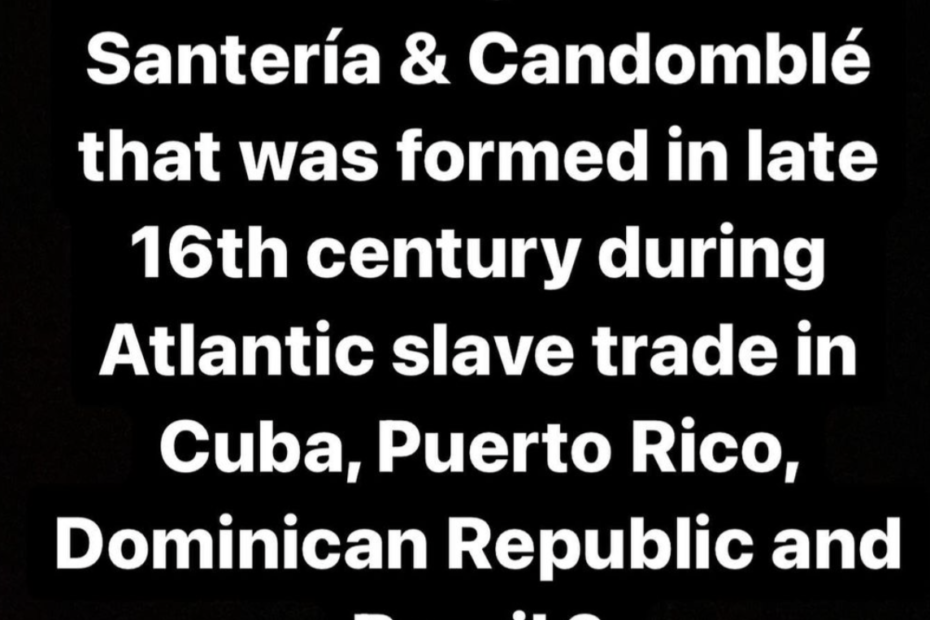Candomblé is an African diasporic religion formed in 16th century that developed in Brazil during the 19th century. It arose through a process of syncretism between several of the traditional religions of West Africa, especially those of the Yoruba, Bantu, and Gbe. There is some influence of Roman Catholic form of Christianity. There is no central authority in control of Candomblé, which is organized around autonomous terreiros (houses).
The name itself Candomblé means( ‘dance in honour of the gods).. and music and dance are important parts of Candomblé ceremonies because the Brazilians love to Dance ..
Santería also known as Regla de Ocha, also is an African diasporic religion that developed in Cuba during the late 19th century. It arose through a process of syncretism between the traditional Yoruba religion of West Africa, the Catholic form of Christianity, and Spiritism. There is no central authority in control of Santería and much diversity exists among practitioners, who are known as creyentes..
Santería is practiced in Cuba , Puerto Rico , Dominican Republic and more Caribbean countries .. While Candomblé is practiced in Brazil ..
Santería teaches the existence of an overarching divinity, known as Olodumare or Olorun ..Practitioners believe that this divinity created the universe but takes little interest in human affairs.As this creator deity is inaccessible to humanity,no major offerings are dedicated to it…The two facets of this divinity are understood slightly differently; Olodumare represents the divine essence of all that exists, Olorun is regarded as the creator of all beings, this deity displays similarities with the Christian Trinity..
Both Santería and Candomblé Worship deities (ORIŚAS ) :
OLODUMARE ( GOD )
ORUNMILA (the ORISHA of Wisdom&Knowledge)
IFA OLOKUN (Oracle)
IYE MAJA (Mermaid)
OSHUN (River Goddess)
OBATALA (The creator )
OGUN (god of iron )
SHANGO (god of Thunder )
ÒYA (river goddess )
EGUNGUN (Masquerade)
OSANYIN (Spiritism)
Santería developed among Afro-Cuban communities following the Atlantic slave trade of the 16th to 19th centuries. It formed through the blending of the traditional religions brought to Cuba by enslaved West Africans, the majority of them Yoruba, and Roman Catholicism, the only religion legally permitted on the island by the Spanish colonial government. In urban areas of West Cuba, these traditions merged with Spiritist ideas to form the earliest casas during the late 19th century. After the Cuban War of Independence resulted in an independent republic in 1898, its new constitution enshrined freedom of religion..
The late 20th century saw growing links between Santería and related traditions in West Africa and the Americas, such as Haitian Vodou and Brazilian Candomblé. Since the late 20th century, some practitioners have emphasized a “Yorubization” process to remove Roman Catholic influences and created forms of Santería closer to traditional Yoruba religion.
Slavery was widespread in West Africa; most slaves were prisoners of war captured in conflicts with neighbouring groups, although some were convicted criminals.The first enslaved Africans arrived in Cuba in 1511,although the largest numbers came in the 19th century. Cuba continued to receive new slaves until at least 1860,with full emancipation occurring in 1886.In total, between 702,000 and 1 million enslaved Africans were brought to Cuba…Most came from a stretch of Western Africa between the modern nation-states of Guinea and Angola. The great plurality were Yoruba, from the area encompassed by modern Nigeria and Benin; the Yoruba had a shared language and culture but were divided among different states. They largely adhered to Yoruba traditional religion especially (YEMÒJA ) which incorporated many local orisha cults although with certain orisha worshipped widely due to the extent of the Yoruba-led Oyo Empire
In Cuba, slaves were divided into groups termed naciones (nations), often based on their port of embarkation rather than their own ethno-cultural background; those who were Yoruba speakers, as well as Arara and Ibo people, were identified as the “Lucumí nation” Enslaved West Africans brought their traditional religions with them to Cuba..some were from the priestly class and possessed knowledge of traditions such as Ifá and Egungun .. While hundreds of orisha were worshipped across West Africa, fewer than twenty became prominent in Santería, perhaps because many kin-based orisha cults were lost when traditional kinship networks were destroyed through enslavement..
Slavery has done more damage than good to the Africans .. But the ORISHAs worshipers in diaspora such as Cuba , Puerto Rico , El Salvador , Dominican Republic , Brazil and more Caribbean countries are Yoruba descendants ..
Santería and Candomblé worshipers travel from all over the world to Nigeria during deities Festival most especially OSUN oshogbo festival..
#Africanhistory#Nigerianhistory#Historylovers
